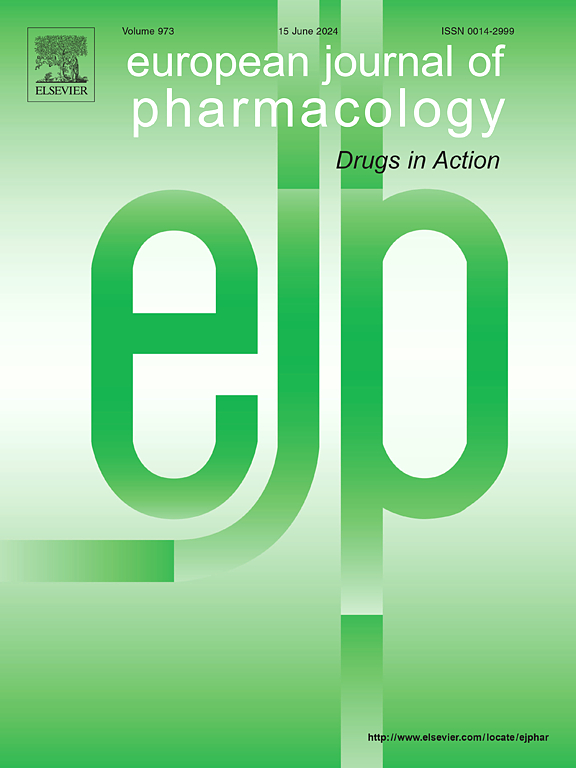SGLT2 inhibitor dapagliflozin mitigates skeletal muscle pathology by modulating key proteins involved in glucose and ion homeostasis in an animal model of heart failure
IF 4.2
3区 医学
Q1 PHARMACOLOGY & PHARMACY
引用次数: 0
Abstract
Heart failure (HF) is a syndrome characterized by dyspnoea, fatigue and exercise intolerance. Among non-cardiac comorbidities which often accompany HF, skeletal muscle abnormalities impact patients’ daily activities and quality of life. Sodium-glucose cotransporter 2 inhibitors (SGLT2i) have shown promise in improving clinical outcomes and enhancing physical performance in HF patients, although their mechanism of action remains unclear. In this context, altered muscle ions and glucose homeostasis may contribute to HF-related muscle changes and serve as indirect targets for SGLT2i effects. To explore this further, we used Dahl salt-sensitive rats fed with a high-salt diet for five weeks and then randomized to receive dapagliflozin (HS + DAP) or vehicle (HS) for the following six weeks. Control animals received a low-salt diet (LS). We investigated whether variations in indexes of glucose and ions homeostasis occur in extensor digitorum longus muscle of this rodent model of HF with preserved ejection fraction and are counteracted by dapagliflozin treatment. Gene and protein expression analysis revealed altered expression of proteins involved in glucose (SGLT2, GLUT4, GPD1) and Ca2+ and Na + homeostasis (NCX3, Ryr1, NHE1/6, Na+/K+-ATPase, Nav1.4) in HS vs LS animals. Furthermore, HS rats showed an increased CaMKII expression in its active phosphorylated form and a change in plasma pH toward acidification. Dapagliflozin treatment counteracted the altered expression of most of the components under investigation, also promoting an amelioration of atrophy indexes and a recovery of plasma pH. Thus, skeletal muscle appears highly responsive to SGLT2i treatment, supporting the potential of these drugs in mitigating HF-related muscle pathology.
在心力衰竭动物模型中,SGLT2抑制剂达格列净通过调节参与葡萄糖和离子稳态的关键蛋白来减轻骨骼肌病理
心力衰竭(HF)是一种以呼吸困难、疲劳和运动不耐受为特征的综合征。在常伴随HF的非心脏合并症中,骨骼肌异常影响患者的日常活动和生活质量。钠-葡萄糖共转运蛋白2抑制剂(SGLT2i)在改善心衰患者的临床结果和增强身体机能方面显示出希望,尽管其作用机制尚不清楚。在这种情况下,肌肉离子和葡萄糖稳态的改变可能有助于hf相关的肌肉变化,并作为SGLT2i效应的间接靶点。为了进一步探讨这一点,我们使用高盐饮食喂养达尔盐敏感大鼠5周,然后在接下来的6周随机接受达格列净(HS + DAP)或载药(HS)。对照组给予低盐饮食(LS)。我们研究了保存射血分数的HF啮齿类动物模型的指长伸肌中葡萄糖和离子稳态指标的变化是否被达格列净治疗抵消。基因和蛋白表达分析显示,HS与LS动物中葡萄糖相关蛋白(SGLT2、GLUT4、GPD1)和Ca2+和Na+稳态相关蛋白(NCX3、Ryr1、NHE1/6、Na+/K+-ATPase、Nav1.4)的表达发生改变。此外,HS大鼠CaMKII活性磷酸化表达增加,血浆pH向着酸化方向变化。达格列净治疗抵消了研究中大多数成分的表达改变,也促进了萎缩指数的改善和血浆ph值的恢复。因此,骨骼肌对SGLT2i治疗表现出高度反应,支持这些药物在减轻hf相关肌肉病理方面的潜力。
本文章由计算机程序翻译,如有差异,请以英文原文为准。
求助全文
约1分钟内获得全文
求助全文
来源期刊
CiteScore
9.00
自引率
0.00%
发文量
572
审稿时长
34 days
期刊介绍:
The European Journal of Pharmacology publishes research papers covering all aspects of experimental pharmacology with focus on the mechanism of action of structurally identified compounds affecting biological systems.
The scope includes:
Behavioural pharmacology
Neuropharmacology and analgesia
Cardiovascular pharmacology
Pulmonary, gastrointestinal and urogenital pharmacology
Endocrine pharmacology
Immunopharmacology and inflammation
Molecular and cellular pharmacology
Regenerative pharmacology
Biologicals and biotherapeutics
Translational pharmacology
Nutriceutical pharmacology.

 求助内容:
求助内容: 应助结果提醒方式:
应助结果提醒方式:


